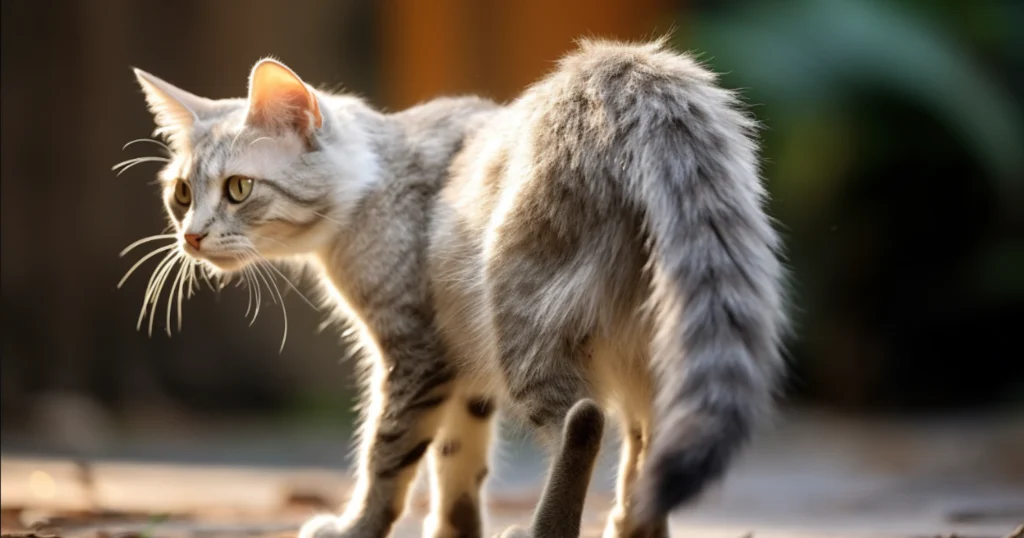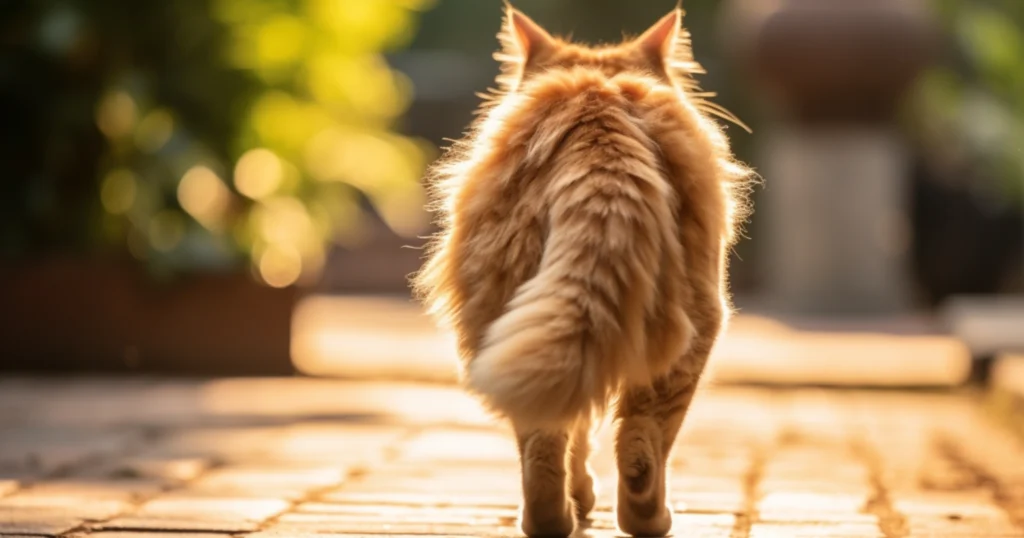Have you ever noticed your cat’s tail vibrating or twitching back and forth rapidly? This unusual tail movement is your cat’s way of communicating something important. Understanding what’s behind those vibrations and shakes can give you insight into how your cat is feeling.
Understanding these signals is pivotal for pet owners. It’s like learning a foreign language, a secret code between you and your furry friend. With a keen eye and a little knowledge, you can decode what your cat’s vibrating tail is trying to tell you. This not only strengthens your bond with your pet, but also makes for effective communication. Now, who wouldn’t want that?
Understanding the Language of Cat’s Tail Movements

A cat’s tail is like a built-in mood ring – it can give you critical insights into how they’re feeling if you learn to read the signs. The position, motion, and overall body language of your cat’s tail provides a wealth of information. Understanding this non-verbal communication system is key for any cat parent.
For starters, pay attention to what your cat’s tail is doing at rest. A relaxed, content kitty will hold their tail straight up or loosely curled. An agitated or upset cat may thrash or swish their tail forcefully. Subtle movements matter too – a tail twitching back and forth can signal irritation or overstimulation.
The key is to look at the whole picture. Take into account your cat’s environment, posture and facial expressions. A wagging tail paired with dilated pupils and flattened ears reads differently than a kitty happily prancing with an upright, vibrating tail.
Bottom line – your cat’s tail provides a running commentary on how they feel. Making the effort to understand the nuances will deepen your bond and help ensure your furry friend’s needs are met. So keep a close eye on the tail tale signs and stay tuned in to what your cat is saying without words.
The Reasons Behind a Cat’s Tail Vibrations

Anxiety and Restlessness
A vibrating or shaking tail can often be a red flag for anxiety or restlessness in cats. This could be triggered by a number of factors, like a new environment, unfamiliar people, or sudden loud noises. In such states, a cat’s tail acts like a stress detector, oscillating rapidly. Ignoring these signs can lead to a stressed-out cat and potential behavioral problems. So, keep an eye out for a jittery tail; it could be your cat’s SOS signal.
Happiness and Excitement
On the flip side, a vibrating tail is not always a sign of distress. Sometimes, it’s a dance of joy! When your cat is super excited or happy to see you, it may strut around with a rapidly vibrating tail. It’s their way of saying, “I’m thrilled!” To confirm this positive state, look for other signs like purring, affectionate rubs, and a relaxed posture. It’s a heartwarming sight when you catch your cat in these blissful moments.
Anger
Just as humans have different ways of expressing anger, so do cats. A violently shaking tail can be an indication of fury or upset. This is not a sign to take lightly; an agitated cat can become aggressive. Other signs to look out for include hissing, flattened ears, and an arched back. In such scenarios, it’s best to give your feline friend some space until they cool down.
Concentration
A subtly twitching tail tip indicates a cat intently watching prey or toys. You’ll see this stealth mode during play as they fixate before pouncing. Outdoors, the tail telegraphs focus when spotting birds or squirrels. A twitching tip signifies concentration versus swishing which conveys agitation. Let your hunter focus – they’re gathering intel before making their move.
Purring
Purring is a common behavior in cats, and it can cause their body to vibrate. But don’t confuse this with tail vibration due to anxiety. Purring is typically a sign of contentment, like when your cat is cozied up on your lap. However, cats may also purr when they’re stressed or unwell. The key is to distinguish between the purr of happiness and the vibration of fear or anxiety. For this, you’ll need to consider other behavioral cues and the situation at hand.
Interpreting Cat’s Tail Vibrations: Dos and Don’ts

Interpreting a cat’s tail vibrations can be like solving a puzzle. Here are some dos and don’ts to help you become a master of this feline language.
Do observe your cat’s overall body language. A tail’s vibration isn’t a standalone message; it’s part of a broader communication system. Combine it with other signals like ear positions, vocalizations, and body postures for a more accurate interpretation.
Don’t ignore a rapidly vibrating tail. It could be a sign of stress or anxiety. Try to identify the cause and eliminate it if possible, or consult with a vet if the behavior persists.
Do watch for a vibrating tail paired with happy signs like purring and rubbing against you. It’s your cat’s way of showing excitement or affection.
Don’t force interaction if your cat’s tail is aggressively shaking. It’s a clear sign of anger or agitation. Give your kitty some space to cool down.
Do note the subtle twitching of the tail tip. It’s a sign your cat is focused and alert, possibly even planning a playful attack on a toy!
Understanding and correctly interpreting these tail vibrations can greatly enhance your bond with your feline friend. It’s all about patience, observation, and love.
Conclusion
A cat’s tail provides a wealth of non-verbal cues if you learn to decipher the signs. Paying attention to your cat’s tail vibrations and movements allows you to better understand their emotional state and needs. Whether it’s excitement, anxiety, anger or concentration, tuning into the tail tale signs will deepen your bond and lead to a happier, healthier kitty. Remember, watching the tail can spell the tale! 😸


